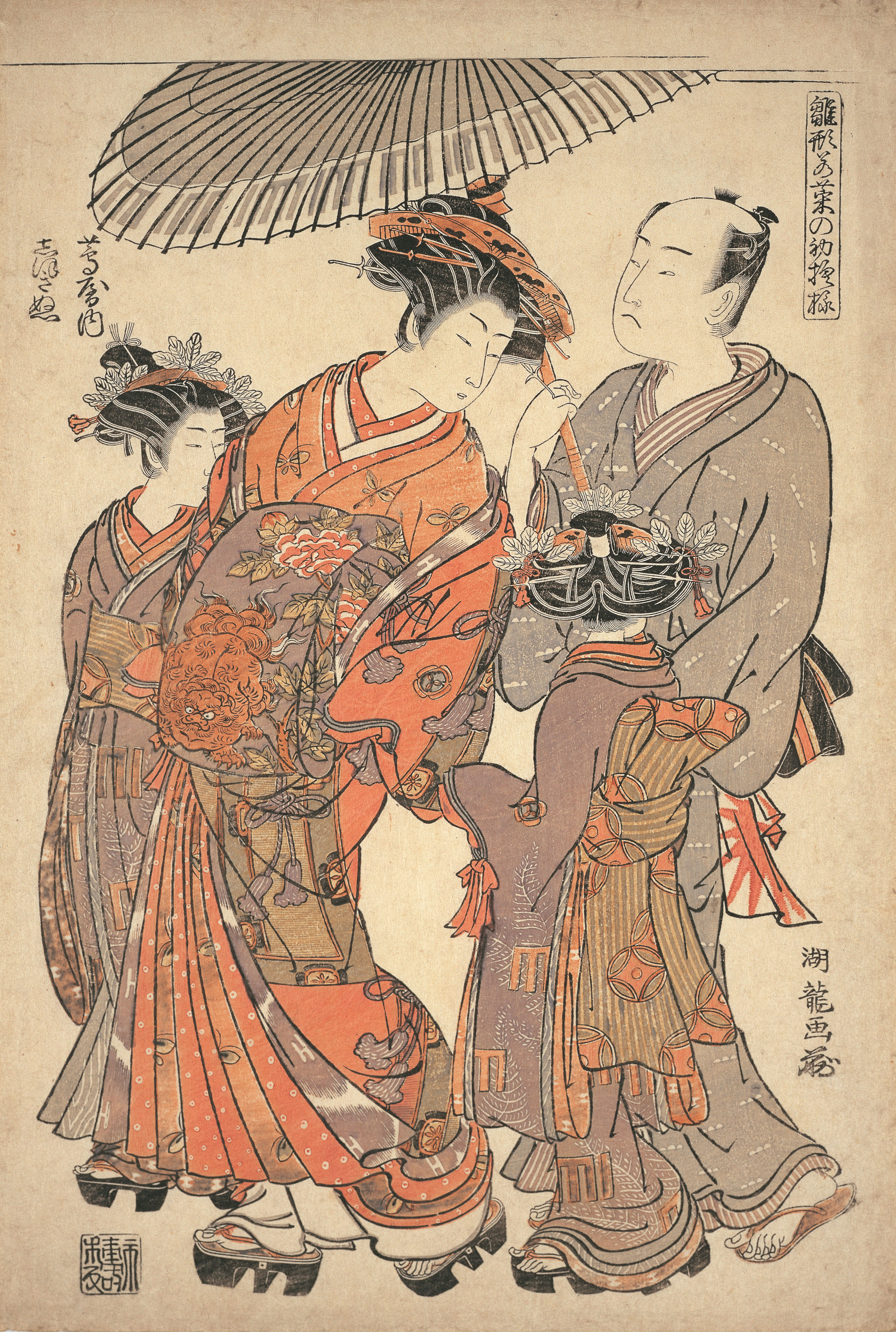
ひながたわかなのはつもよう つたやうちしおぎぬ 雛形若菜の初模様 蔦屋内しほきぬ
ca.1777~1781(安永後期)
大判錦絵
「雛形若菜の初模様」は安永4年(1775)から天明元年(1781)にかけて出版された、100枚を超す大規模なシリーズです。 「若菜の初模様」は正月に初めて着る着物の柄を、「雛形」は見本帳を意味し、遊女と禿(かむろ)のファッションショーを見ているかのような作品です。
本作では、蔦屋の遊女しほきぬが、二人の禿とお付きの男性をつれて遊女道中をしているところが描かれています。禿とは、遊女見習いの少女のことで、位の高い遊女のそば近くに仕えました。禿の一人は後ろ姿で描かれており、結い上げられた髪型の美しさをさりげなくアピールしています。
◆遊女道中【ゆうじょどうちゅう】
位の高い遊女が馴染み客に面会するために郭内の揚屋(あげや)や茶屋に出向く際の往来、あるいは特定の日に郭中を練り歩くこと。
礒田湖龍斎【いそだ こりゅうさい】
生没年 享和20年~?(1735~?)
明和(1764~1772)~安永・天明年間(1772~1789)に活躍し、美人画を多く描きました。
| 寸法 | 38.6×26.2cm |
|---|---|
| 形状 | 版画 |
| 版元 | 西村屋与八 |

The Courtesan Shioginu of the Tsutaya House, from the "Models for Fashion: New Year Designs as Fresh as Herbs" series
ca.1777~1781
The Japanese title is Hinagata-wakana-no-hatsumoyo. Hinagata means a sample book and Wakana-no-hatsumoyo refers to designs of new kimono clothes for new year’s day. There are over 100 woodblock prints in the entire series. The series was published over the period starting in the 4th year of the Anei era (1775) and continuing to the 1st year of the Tenmei era (1781) during the Edo period. Each piece features a famous courtesan in a kimono that has just been designed for the coming New Year, in a way that closely resembles the pose a model takes on the runway at a modern fashion show.
This piece depicts the courtesan Shioginu of the Tsutaya House, walking along a street for her yujo dochu trip, accompanied by her three attendants, two kamuro girls and one man. Kamuro are young girls who are apprentice courtesans. They perform various kinds of services for high-ranking courtesans. One of the kamuro girls in this picture is depicted from behind, probably in order to highlight the beauty of her stylish hairdo.
◆ Yujo dochu
The phrase Yujo dochu refers to the trip of a high-ranking courtesan as she walks down the street to meet a customer waiting for her at an ageya (a house of assignation) or a hikitejaya (a type of tea house which arranges meetings of courtesans with customers) located in the pleasure quarter. It is also used to refer to a parade of courtesans, together with their subordinates, walking through the streets of the pleasure quarter on special days.
Isoda Koryusai (1735 – ?)
Isoda Koryusai was active during the period from the Meiwa era (1764 – 1772) to the Anei and Tenmei eras (1772 – 1789).
He drew a number of bijin-ga (pictures of beautiful women).
| Size | 38.6×26.2cm |
|---|

雛形若菜初模樣 蔦屋內Shihokinu
ca.1777~1781
《雛形若菜之初模樣》是安永4年(1775年)至天明元年(1781年)出版的,超過100幅的超大規模係列。“若菜之初模樣”是指正月裏第一次穿的和服紋樣,“雛形”意味著樣品冊,此作品就好像在看藝妓與隨從的時裝秀一樣。
此作品中,描畫的是蔦屋的藝妓Shihokinu,帶著兩個侍女(禿)與隨從遊街的場景。“禿”是指實習藝妓,侍奉高等藝妓。畫中展現了其中一個侍女的背影,也不經意地表現了盤發之美。
【遊女道中】
高等藝妓為了與熟客會麵,來往於城內的酒館或茶館,或在特定的日子在城中巡遊。
礒田湖龍齋(Isoda Koryusai)
生卒年 享和20年~ ?(1735~ ?)
活躍於明和(1764~ 1772)~安永、天明年間(1772 ~1789),創作了大量美人畫。
| 尺寸 | 38.6×26.2cm |
|---|

『히나가타 와카나의 첫 모양(기녀들의 설날 기모노 견본집)』 <기방 츠루야의 기녀 시오기누>
ca.1777~1781
「히나가타 와카나의 첫 모양」은 안에이 4년(1775)부터 덴메이 원년(1781)에 걸쳐 출판된 100장이 넘는 대규모의 시리즈 작품입니다. 제목에 쓰인 용어, “와카나의 첫 모양”이란 새해 첫 날에 입는 기모노의 무늬를 뜻하고, “히나가타”는 견본집을 뜻합니다. 이 작품은 기녀와 가무로(견습 기녀)의 패션쇼를 보고 있는 듯한 작품입니다.
본 작품에서는 츠루야라는 기생집의 기녀 시오기누가 두명의 가무로를 데리고 남성 손님과 함께 유곽 안을 거닐고 있는 모습(遊女道中)이 그려져 있습니다. 여기서 가무로는 기녀가 되고자 하는 소녀 견습생을 칭하며, 가무로는 지위가 높은 기녀의 시중을 들었습니다. 가무로 중 한명은 뒷모습을 보여주며 올려 묶은 머리 모양의 아름다움을 거침없이 뽐내고 있네요.
※유녀도중(遊女道中=기녀의 유곽 안 산책)
지위가 높은 기녀가 단골 손님과 만나기 위해 유곽 안의 요정이나 찻집을 오고 갈 때 또는 정해진 날에 기방 주변의 정해진 길을 천천히 걷는 것.
이소다 코류사이
[쿄와20년~?(1735~?)]
메이와(1762~1772)부터 안에이・덴메이(1772~1789) 시기에 활약하였고, 미인화를 많이 그렸습니다.
| 치수 | 38.6×26.2cm |
|---|
